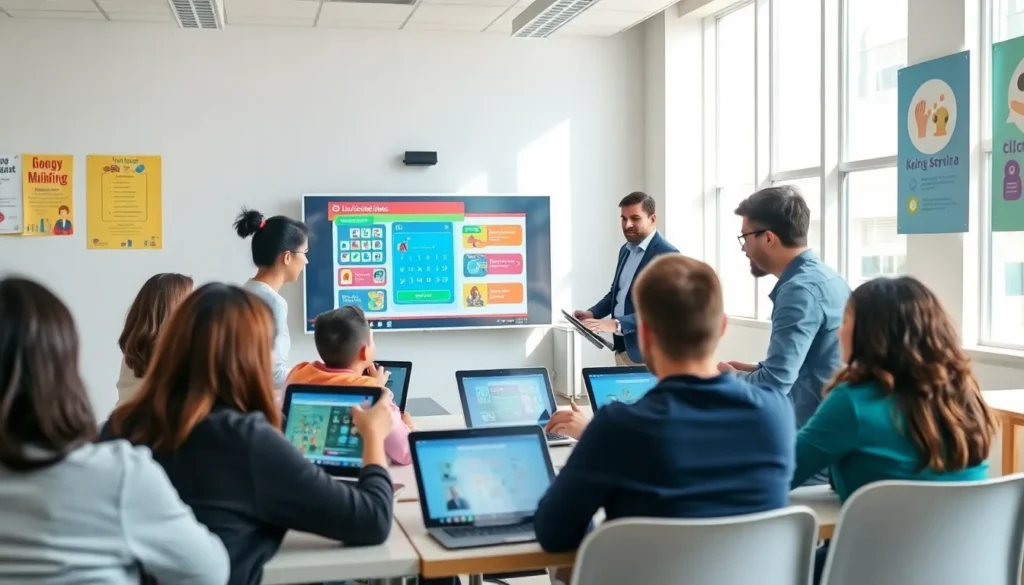Imagine a world where learning is as engaging as scrolling through your social media feed. EdTech programs are making that a reality, transforming classrooms into innovative learning environments that captivate students’ attention. Education technology, or EdTech for short, isn’t just a buzzword: it’s a game changer. Whether it’s through interactive apps, virtual classrooms, or AI-powered tools, these programs are reshaping how knowledge is delivered and consumed. So, buckle up as we explore the revolutionary landscape of EdTech programs.
Table of Contents
ToggleWhat Are EdTech Programs?

EdTech programs encompass a broad range of technological tools and applications that aid in education. They include software, hardware, and enhanced learning platforms designed to create engaging learning experiences. Think of online course management systems, educational apps, and even robotics that enhance the learning process. Essentially, if it uses technology to help learning, it falls under the EdTech umbrella. This innovation isn’t limited to classrooms: it can also be found in corporate training environments, making learning accessible anytime and anywhere.
The Importance of EdTech Programs
The significance of EdTech programs cannot be overstated. They provide personalized learning experiences, accommodating different learning styles and paces. For instance, some students may thrive with visual aids, while others prefer interactive modules. By leveraging technology, educators can tailor their approach, ensuring that no one gets left behind.
Also, these programs promote collaboration among students. Through various platforms, learners can work together on projects, share ideas, and receive immediate feedback from peers and instructors alike. This interaction fosters a sense of community, an essential element for effective learning.
Plus to personalized experiences, EdTech programs can bridge geographic gaps. Students in remote areas can access high-quality educational resources that were once out of reach, leveling the playing field for all.
Types of EdTech Programs
When it comes to EdTech, variety is the spice of life. Here are some common types of programs:
- Learning Management Systems (LMS) – These platforms help educators manage courses, track student progress, and administer assessments. Popular examples include Moodle and Canvas.
- Gamified Learning – Programs that incorporate game mechanics into educational content make learning fun. They turn lessons into interactive challenges, attracting students who might otherwise disengage.
- Virtual and Augmented Reality (VR/AR) – Imagine taking a field trip to ancient Rome without leaving your classroom. VR and AR programs create immersive learning experiences that enhance comprehension and retention.
- Interactive Apps – These mobile applications offer on-the-go learning. Whether it’s language learning apps like Duolingo or math practice apps like Photomath, they make education accessible anytime.
- Artificial Intelligence (AI) – AI-driven EdTech tools can analyze student performance and adapt content accordingly. Programs like DreamBox Learning use AI to tailor lessons based on individual learner needs.
Key Features of Effective EdTech Programs
Effective EdTech programs share several common features:
- User-Friendly Interface – A clean, intuitive interface makes it easier for both teachers and students to navigate.
- Customization Options – Programs that allow users to tailor their learning experiences are often more successful.
- Analytics and Reporting – Tracking progress and outcomes helps educators refine their teaching methods. Strong analytics features provide insights into student engagement and performance.
- Interactivity – Programs that engage students through interactive elements, such as quizzes and discussion forums, tend to be more effective.
- Support and Resources – Comprehensive resources, including tutorials and customer service, can significantly enhance user experience.
Challenges in Implementing EdTech Programs
Of course, no revolution comes without its challenges. Many schools and organizations face hurdles when incorporating EdTech:
- Budget Constraints – Not every institution has the funds to invest in high-quality EdTech solutions. This can limit the range of tools available to educators and students.
- Resistance to Change – Some educators may be hesitant to adopt new technologies, preferring traditional teaching methods. Overcoming this mindset requires effective training and convincing demonstration of value.
- Training Needs – Both teachers and students may need training to use these technologies effectively, which can take time and resources.
- Equity Issues – Not all students have equal access to technology, leading to disparities in learning opportunities. Finding ways to address this inequality is crucial for successful EdTech implementation.
Future Trends in EdTech
Looking ahead, several trends are poised to shape the future of EdTech:
- Increased Personalization – As AI becomes more sophisticated, expect tailored learning experiences that adapt in real-time to individual learner needs.
- Focus on Social-Emotional Learning (SEL) – Programs that nurture emotional intelligence and interpersonal skills will gain traction, recognizing that education is not just about academic achievements.
- Blended Learning Environments – A mix of traditional and online learning will become standard, blending the benefits of both worlds. Classrooms may become more like collaborative hubs than lecture halls.
- Digital Assessment Tools – With an emphasis on assessment, tools that provide real-time insights into learner progress will become indispensable.



